YouTube creators have a wealth of monetization strategies at their disposal, such as ad revenue, memberships, and sponsorships, each offering distinct advantages. To foster a loyal audience, engaging content that encourages interaction and community building is essential. Additionally, prioritizing high-quality visuals and sound, along with effective editing, can significantly enhance viewer experience and retention.
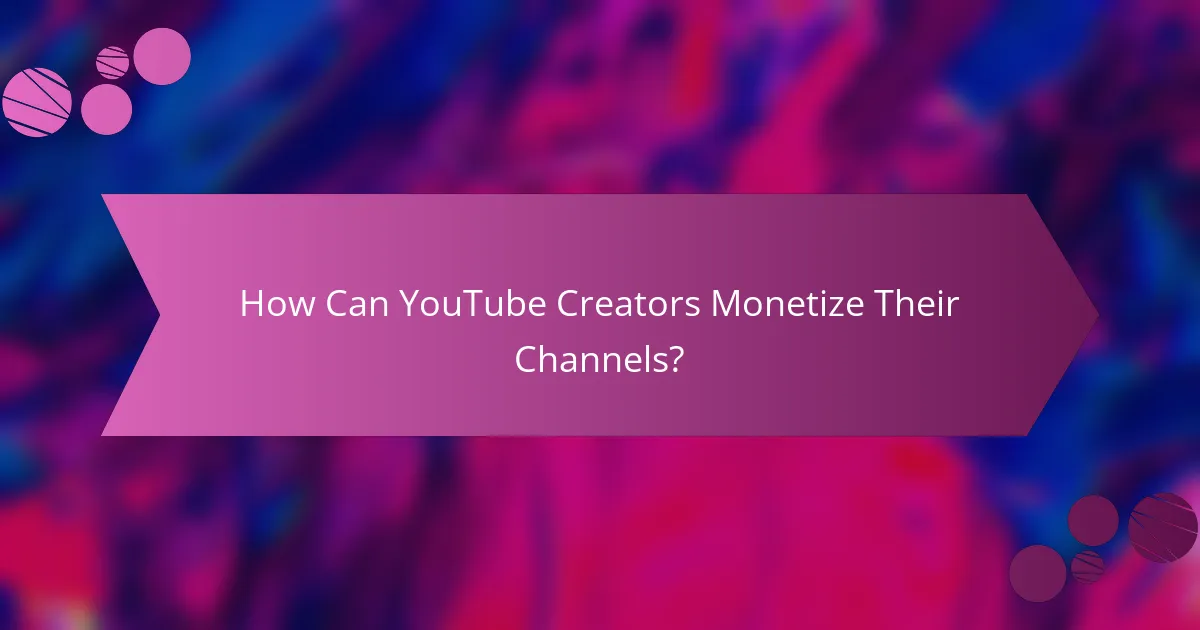
How Can YouTube Creators Monetize Their Channels?
YouTube creators can monetize their channels through various strategies, including ad revenue, memberships, sponsorships, merchandise, and affiliate marketing. Each method offers unique benefits and challenges, allowing creators to diversify their income streams.
Ad Revenue through YouTube Partner Program
The YouTube Partner Program (YPP) allows creators to earn money from ads displayed on their videos. To qualify, channels must have at least 1,000 subscribers and 4,000 watch hours in the past 12 months. Once accepted, creators can earn revenue based on ad impressions and viewer engagement.
Creators should optimize their content for ad placements by maintaining viewer retention and adhering to YouTube’s content guidelines. It’s essential to monitor analytics to understand which videos generate the most ad revenue and adjust strategies accordingly.
Channel Memberships and Super Chat
Channel memberships enable fans to support creators through monthly subscriptions in exchange for exclusive perks, such as badges and access to members-only content. Creators need at least 30,000 subscribers to enable this feature, which can significantly enhance revenue.
Super Chat allows viewers to pay to have their messages highlighted during live streams. This feature can be lucrative during engaging live sessions, as fans often want to stand out and interact directly with creators.
Sponsorships and Brand Deals
Sponsorships and brand deals involve partnering with companies to promote their products or services in exchange for payment. Creators can negotiate deals based on their audience size and engagement rates, often resulting in higher earnings than ad revenue alone.
When pursuing sponsorships, creators should ensure that the brands align with their content and values to maintain authenticity. Clear communication about deliverables and expectations is crucial for successful partnerships.
Merchandise Sales
Creators can sell branded merchandise, such as clothing, accessories, or digital products, to their audience. This approach not only generates revenue but also strengthens the creator’s brand identity. Platforms like Teespring or Shopify can simplify the process of setting up an online store.
To maximize merchandise sales, creators should promote their products through videos and social media, showcasing how they resonate with their audience. Limited-time offers or exclusive items can create urgency and boost sales.
Affiliate Marketing
Affiliate marketing involves promoting products or services and earning a commission for each sale made through a unique referral link. This strategy is effective for creators who review or recommend products relevant to their audience.
To succeed in affiliate marketing, creators should choose products that genuinely align with their content and audience interests. Transparency about affiliate relationships is essential to maintain trust with viewers.
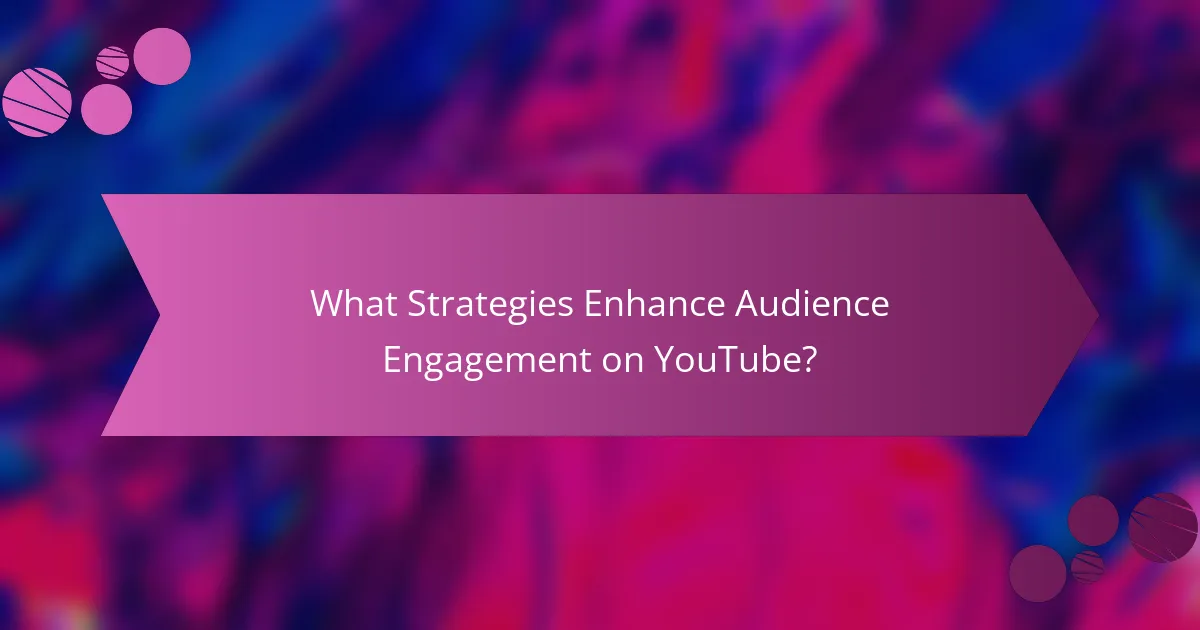
What Strategies Enhance Audience Engagement on YouTube?
Enhancing audience engagement on YouTube involves creating content that resonates with viewers, encourages interaction, and builds a community. Effective strategies include creating interactive content, utilizing community posts, responding to comments, and hosting live streaming events.
Creating Interactive Content
Interactive content encourages viewers to participate actively rather than passively consuming videos. This can include polls, quizzes, or challenges that invite audience input and feedback. For example, creators can ask viewers to vote on the next video topic or participate in a challenge related to the content.
To maximize engagement, consider incorporating elements that require viewer participation, such as asking questions during videos and prompting viewers to comment with their answers. This not only fosters interaction but also helps build a sense of community among subscribers.
Utilizing Community Posts
Community posts allow creators to share updates, polls, and behind-the-scenes content directly with their audience. These posts can be an effective way to keep subscribers informed and engaged between video uploads. For instance, creators can use polls to gauge interest in upcoming content or share sneak peeks of new videos.
To leverage community posts effectively, aim to post regularly and ensure the content is relevant and engaging. This approach can help maintain viewer interest and encourage more interaction, leading to a stronger connection with the audience.
Responding to Comments
Responding to comments is crucial for fostering a sense of community and showing viewers that their opinions matter. Engaging with comments can lead to increased loyalty and encourage more viewers to participate in discussions. Aim to respond to a mix of positive and constructive feedback to create a balanced dialogue.
To enhance this strategy, consider dedicating time each week to interact with comments on your videos. Acknowledging viewers by name or addressing specific points can make responses feel more personal and encourage further engagement.
Live Streaming Events
Live streaming events provide a unique opportunity for real-time interaction with your audience. These sessions can include Q&As, tutorials, or casual chats, allowing viewers to engage directly with the creator. Live streams can significantly boost engagement as they create a sense of urgency and exclusivity.
When planning a live stream, promote the event in advance to maximize attendance. Consider using interactive features like live polls or chat questions to keep viewers engaged throughout the stream. This not only enhances the experience but also encourages viewers to return for future events.
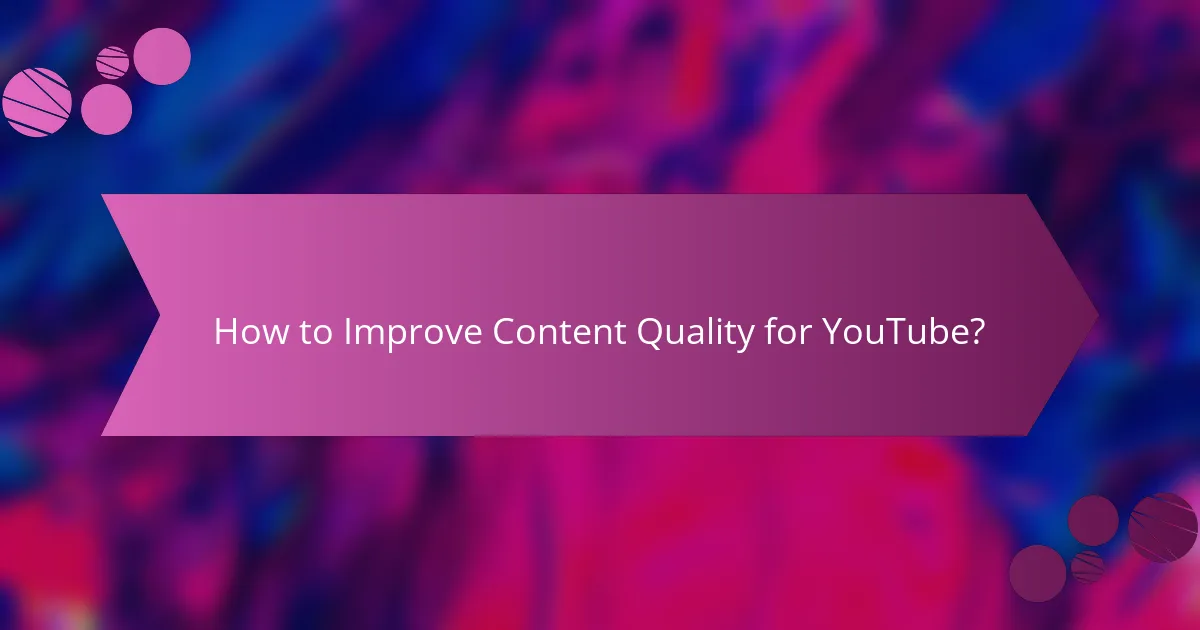
How to Improve Content Quality for YouTube?
Improving content quality for YouTube involves enhancing visual and audio elements, refining editing techniques, and understanding what resonates with your audience. Focus on investing in the right equipment, mastering editing software, planning your content effectively, and tailoring your videos to audience preferences.
Investing in Quality Equipment
Quality equipment can significantly elevate your video production. Consider investing in a good camera, microphone, and lighting setup, as these elements directly influence the viewer’s experience. A decent camera can range from a few hundred to several thousand dollars, while a quality microphone can be found for under $100.
When selecting equipment, prioritize features that enhance clarity and professionalism. For example, a camera with at least 1080p resolution and a microphone that minimizes background noise can make a noticeable difference in your videos.
Editing Techniques and Software
Effective editing can transform raw footage into polished content. Familiarize yourself with popular editing software like Adobe Premiere Pro, Final Cut Pro, or more budget-friendly options like DaVinci Resolve. Each offers unique features that can help improve pacing, transitions, and overall flow.
Learn basic editing techniques such as cutting unnecessary footage, adding music, and incorporating graphics. Aim for a final video length that keeps viewers engaged, typically between 8 to 15 minutes, depending on your content type.
Content Planning and Scripting
Planning and scripting your content can enhance coherence and engagement. Start by outlining your video’s main points and creating a script that guides your delivery. This helps maintain focus and ensures you cover all necessary information.
Consider using a storyboard to visualize your video structure. This can help you identify key scenes and transitions, making the filming process smoother and more efficient.
Understanding Audience Preferences
To improve content quality, it’s crucial to understand what your audience enjoys. Analyze viewer feedback, comments, and analytics to identify popular topics and formats. This insight allows you to tailor your content to meet their interests.
Engage with your audience through polls or community posts to gather direct input on what they want to see. Regularly adapting your content based on audience preferences can lead to higher engagement and retention rates.
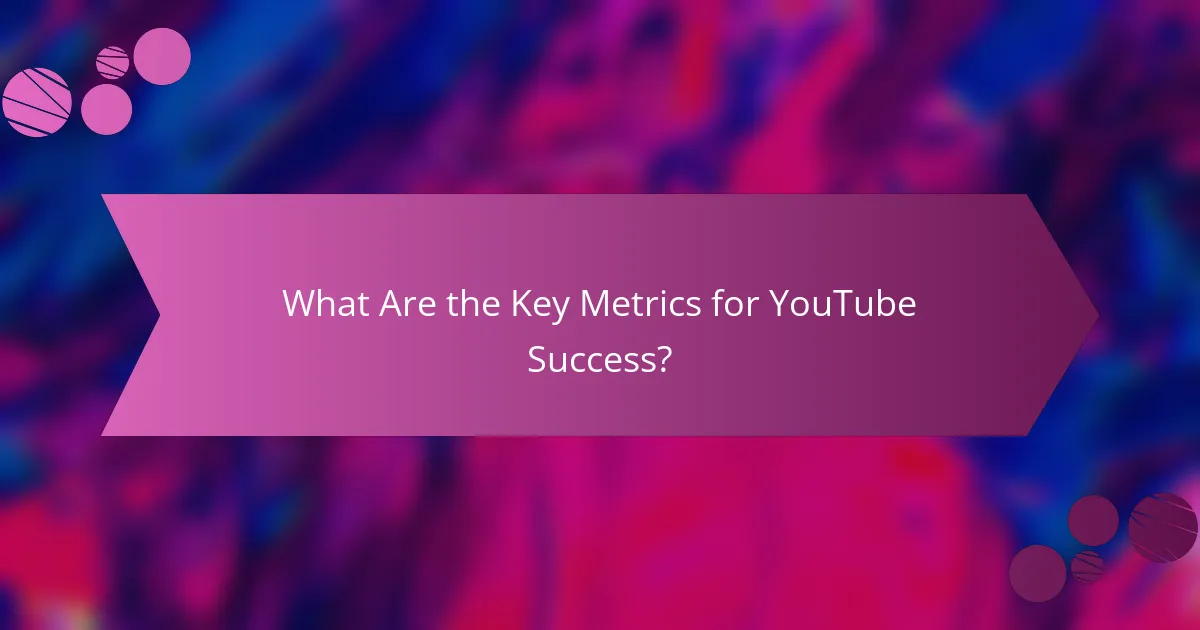
What Are the Key Metrics for YouTube Success?
The key metrics for YouTube success include watch time, audience retention, engagement rate, click-through rate, and subscriber growth rate. These metrics help creators understand how well their content resonates with viewers and inform strategies for improvement.
Watch Time and Audience Retention
Watch time refers to the total minutes viewers spend watching your videos, while audience retention measures how long viewers stay engaged with your content. Both metrics are crucial as they directly influence your video’s ranking in YouTube’s algorithm, impacting visibility and monetization opportunities.
To improve watch time, focus on creating compelling content that keeps viewers interested. Aim for an average audience retention rate of over 50% for optimal performance. Consider using hooks in the first few seconds to captivate your audience and encourage them to watch until the end.
Engagement Rate and Click-Through Rate
Engagement rate measures how viewers interact with your content through likes, comments, shares, and subscriptions. Click-through rate (CTR) indicates the percentage of viewers who click on your video after seeing the thumbnail and title. Both metrics are essential for gauging how appealing your content is to potential viewers.
To boost engagement, encourage viewers to comment and share their thoughts. Using engaging thumbnails and titles can significantly increase your CTR, ideally aiming for a CTR of 5% or higher. Regularly analyze your analytics to identify which videos perform best and replicate those strategies.
Subscriber Growth Rate
Subscriber growth rate measures how quickly your channel gains new subscribers over a specific period. A healthy growth rate indicates that your content is resonating with viewers and encourages them to follow your channel for more updates.
To enhance your subscriber growth, consistently post high-quality content and engage with your audience through comments and social media. Consider running promotions or collaborations with other creators to attract new subscribers. Aim for a growth rate of 10-20% monthly to maintain a thriving channel.
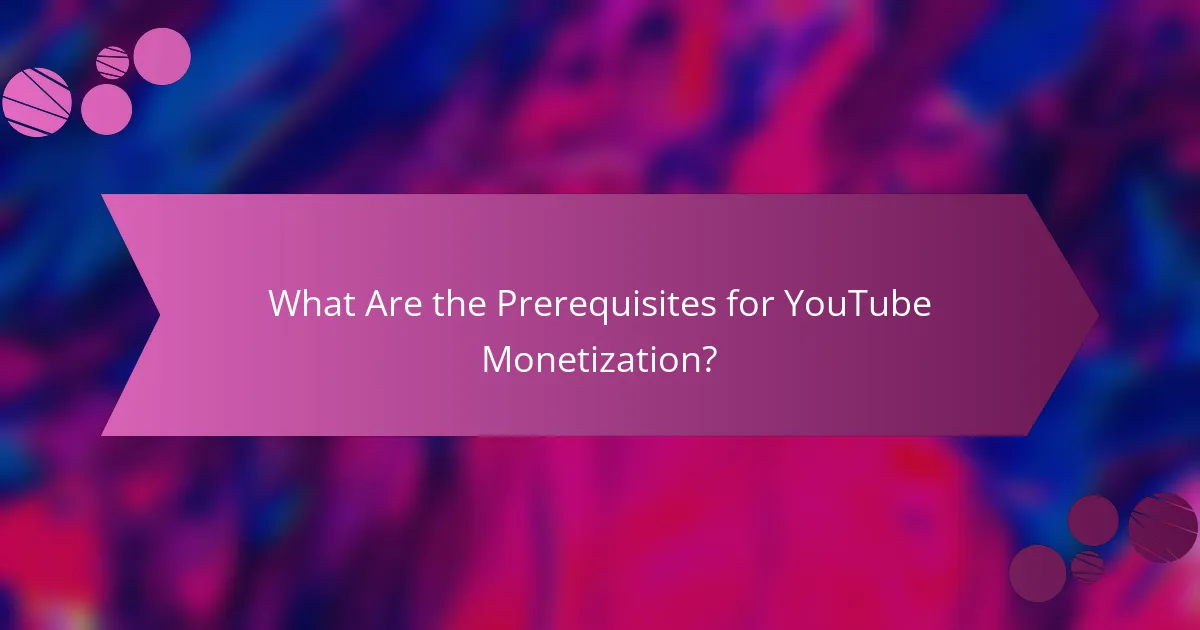
What Are the Prerequisites for YouTube Monetization?
To monetize content on YouTube, creators must meet specific criteria set by the platform. This includes joining the YouTube Partner Program, building a substantial subscriber base, and ensuring that content adheres to community guidelines and copyright laws.
Meeting YouTube Partner Program Requirements
To qualify for the YouTube Partner Program (YPP), creators need at least 1,000 subscribers and 4,000 watch hours over the past 12 months. Additionally, they must comply with all of YouTube’s policies and guidelines, including adhering to copyright regulations.
Once these thresholds are met, creators can apply for monetization through their YouTube Studio dashboard. Approval can take time, so it’s essential to maintain consistent content quality and engagement during this period.
Building a Subscriber Base
A strong subscriber base is crucial for monetization on YouTube. Creators should focus on producing engaging content that resonates with their target audience, as this will encourage viewers to subscribe. Regularly posting videos and interacting with viewers through comments can also help grow the subscriber count.
Promoting the channel on social media platforms and collaborating with other creators can further enhance visibility. Aim for steady growth rather than overnight success; gaining subscribers typically takes time and effort.
Creating Compliant Content
Content must comply with YouTube’s community guidelines to be eligible for monetization. This includes avoiding hate speech, graphic violence, and explicit content. Creators should familiarize themselves with these guidelines to prevent potential demonetization.
Additionally, copyright compliance is vital. Use royalty-free music and obtain permission for any third-party content featured in videos. Regularly reviewing YouTube’s policies can help creators stay informed about any changes that may affect their monetization status.


